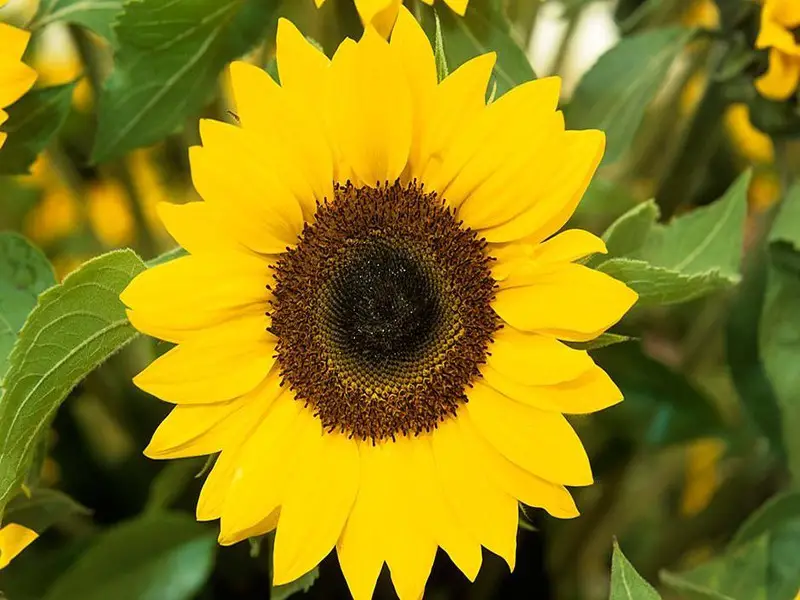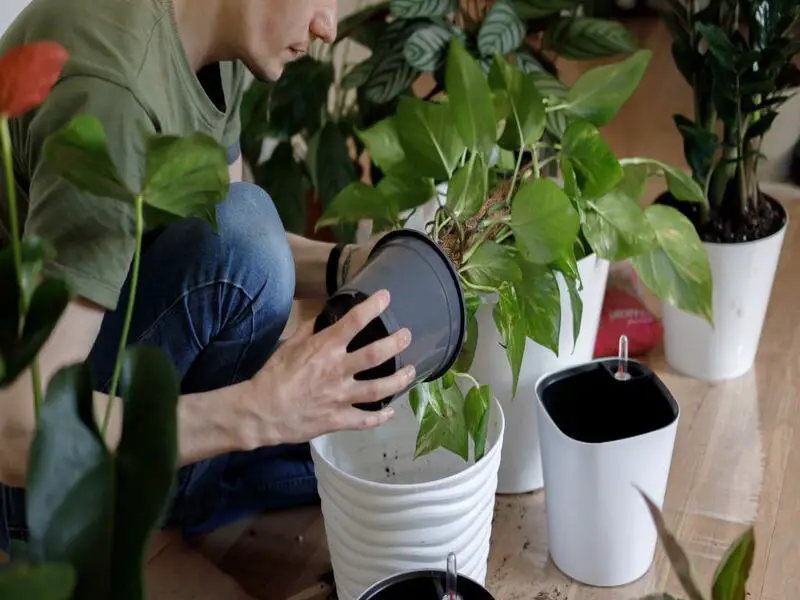Introduction: Unveiling the Beauty and Wonder of Sunflowers
Sunflowers, the epitome of radiant beauty, have captivated humans for centuries with their vibrant hues and towering presence. These magnificent plants, known scientifically as Helianthus annuus, are native to North and Central America but have since spread their charm across the globe. In this article, we delve into the world of sunflowers and uncover six fascinating curiosities about this beloved plant. So, buckle up and get ready to explore the secrets hidden within the sunflower’s golden petals!
Sunflower Beautiful Plant! Discover Now 6 Curiosities!

1. Sunflowers: Masters of Heliotropism
Heliotropism, a phenomenon that showcases the sunflower’s unique adaptability, is our first curiosity. This mesmerizing behavior refers to the plant’s ability to orient itself towards the sun, following its path from east to west throughout the day. Have you ever noticed how a sunflower’s face follows the sun as it moves across the sky? This remarkable trait, known as solar tracking, ensures that sunflowers receive maximum sunlight for photosynthesis. What an ingenious way for these plants to harness the power of the sun!
2. A Spiraling Mathematical Marvel
Let’s unravel the second curiosity of our sunflower adventure: the stunning pattern displayed by the seeds in the flower head. Sunflower seeds follow an intricate mathematical arrangement known as the Fibonacci sequence. This sequence, named after the Italian mathematician Leonardo Fibonacci, is created by adding the two preceding numbers to obtain the next one (0, 1, 1, 2, 3, 5, 8, 13, and so on). In sunflowers, this sequence governs the arrangement of seeds spiraling clockwise and counterclockwise, resulting in a mesmerizing pattern that showcases nature’s mathematical prowess.
3. Sunflowers and their Superpowers
Our third curiosity lies in the amazing benefits sunflowers offer beyond their aesthetic appeal. Did you know that sunflowers possess phytoremediation capabilities? Phytoremediation is the process by which plants extract pollutants and contaminants from the soil, air, or water. Sunflowers have been found to absorb heavy metals such as lead, arsenic, and uranium, making them valuable allies in environmental cleanup efforts. With their roots in the soil and their heads held high, sunflowers truly embody the spirit of eco-warriors!
4. A Sunflower Tapestry: More Than Meets the Eye
As we venture deeper into the world of sunflowers, our fourth curiosity unveils the diverse range of colors they exhibit. While the bright yellow petals are undoubtedly the most popular, sunflowers also come in various shades of red, orange, and even bicolor combinations. These captivating hues are the result of careful breeding and hybridization, allowing us to enjoy a kaleidoscope of colors within the sunflower family. So, the next time you encounter a sunflower, take a moment to admire its vibrant palette.
5. From Beauty to Nourishment: Sunflower Seeds on Your Plate
Now, let’s explore the fifth curiosity and delve into the culinary delights sunflower seeds offer. These tiny powerhouses are not only a tasty snack but also a nutritional treasure trove. Packed with essential nutrients, sunflower seeds are rich in healthy fats, fiber, protein, and an array of vitamins and minerals. They make for a great addition to salads, baked goods, or enjoyed on their own as a satisfying snack. So, the next time you’re looking for a healthy and flavorful option, turn to the mighty sunflower seed!
6. Sunflower Oil: A Versatile Companion
Our final curiosity takes us into the realm of sunflower oil, a versatile and widely used culinary ingredient. Extracted from sunflower seeds, this golden oil is not only delicious but also offers numerous health benefits. With its high smoke point and mild flavor, sunflower oil is an excellent choice for cooking, frying, and baking. Additionally, it is low in saturated fats and rich in vitamin E, making it a heart-healthy option. So, whether you’re sautéing vegetables or preparing a delectable salad dressing, sunflower oil can be your trusty kitchen companion.
Frequently Asked Questions about Sunflowers
Now that we have unraveled the curiosities of sunflowers, let’s address some common questions that may arise:
FAQ 1: Can sunflowers grow in different climates?
Yes! Sunflowers are remarkably adaptable and can grow in a variety of climates. They thrive in sunny locations with well-drained soil, but some species can tolerate cooler temperatures and partial shade. By selecting the appropriate sunflower variety for your climate, you can enjoy their beauty regardless of where you live.
FAQ 2: How long do sunflowers bloom?
The duration of sunflower bloom varies depending on the species and environmental conditions. On average, sunflowers bloom for about two to three weeks. However, some varieties may have shorter or longer blooming periods. Enjoy their radiant display while it lasts!
FAQ 3: Can I grow sunflowers in pots or containers?
Yes, you can grow sunflowers in pots or containers, provided they are of sufficient size and depth to accommodate the plant’s root system. Choose dwarf or compact varieties that are better suited for container gardening. Remember to place the pots in a sunny location and provide adequate water and nutrients for optimal growth.
FAQ 4: How do I harvest sunflower seeds?
To harvest sunflower seeds, wait until the flower head turns brown and the back of the flower head becomes yellow or brown. Cut the flower head from the stem, leaving a few inches of stem attached. Hang the flower head upside down in a cool, dry place to dry. Once the flower head is completely dry, gently rub the seeds out using your hands or a fork. Store the seeds in an airtight container for future use.
FAQ 5: Can sunflowers attract birds and beneficial insects?
Absolutely! Sunflowers are known to attract birds, especially seed-eating species like finches and sparrows, who enjoy feasting on the seeds. Additionally, sunflowers also attract beneficial insects such as bees and butterflies, aiding in pollination. Planting sunflowers in your garden can create a vibrant and lively ecosystem.
FAQ 6: Are sunflowers only grown for ornamental purposes?
While sunflowers are undoubtedly admired for their beauty, they have various practical uses as well. Apart from being cultivated as ornamental plants, sunflowers are grown for their seeds, which are used in culinary preparations, bird feed, and oil production. Additionally, sunflower oil has various industrial applications, such as in the production of biodiesel and cosmetics.
Conclusion: Unveiling the Charms of Sunflowers
Sunflowers, with their radiant blooms and intriguing curiosities, continue to mesmerize and inspire us. From their heliotropic tendencies to their mathematical marvel of spiraling seeds, these beautiful plants never cease to amaze. Whether adorning our gardens, providing environmental benefits, or gracing our plates with their nutritious seeds and oil, sunflowers truly hold a special place in our hearts.
So, the next time you come across a sunflower, take a moment to appreciate its splendor and remember the fascinating curiosities that lie within its petals. From their ability to cleanse the environment to their role as a culinary delight, sunflowers bring joy and wonder to our lives.
In conclusion, the sunflower is a remarkable and beautiful plant that deserves our admiration. Its unique traits, such as heliotropism and Fibonacci patterns, showcase the wonders of nature’s design. Whether you’re captivated by their vibrant colors, enjoying their nutritious seeds, or witnessing their environmental benefits, sunflowers never fail to leave a lasting impression.
So, embrace the allure of the sunflower and let it brighten your days. Plant them in your garden, savor their seeds in your meals, and appreciate their resilience and beauty. The sunflower, a true symbol of happiness and positivity, is a gift from nature that continues to amaze and inspire us.




